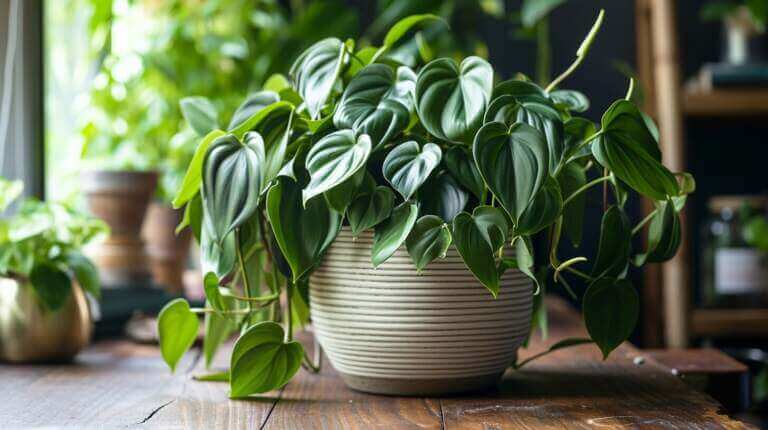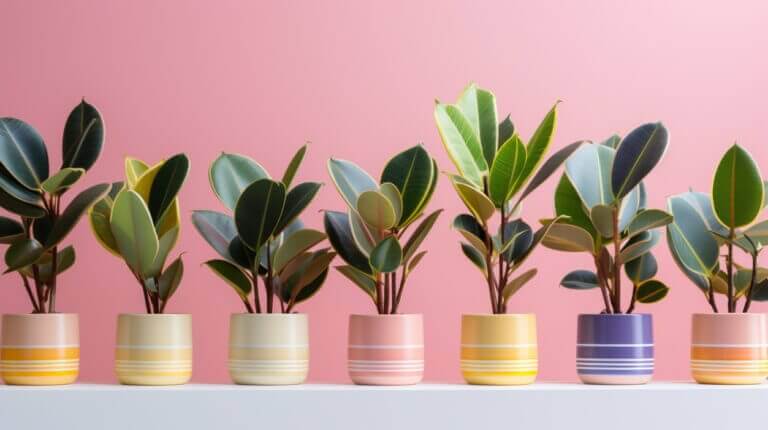Should You Grow Variegated String of Pearls Plant: Senecio Rowleyanus Variegata Care Guide
If you are a succulent enthusiast looking to add a unique and beautiful plant to your collection, the variegated string of pearls may be just what you’re searching for. Also known as Vari Curio Rowleyanus, this trailing succulent plant native to Eastern Africa is highly sought after for its distinctive appearance and care requirements. Before you decide to grow this rare variety of the string of pearls in your home or garden, it is important to understand its appearance and care needs.
Key Takeaways:
- Variegated string of pearls is a beautiful trailing succulent plant with green bead leaves streaked with cream or white color.
- It has a slower growth rate compared to the regular string of pearls due to the lack of chlorophyll in its leaves.
- To care for variegated string of pearls, ensure proper watering, well-draining soil, bright indirect light, and suitable temperature and humidity levels.
- This plant can be grown both indoors and outdoors, depending on your climate and preferences.
- Both variegated and regular string of pearls plants are toxic, so handle them with care and keep them away from children and pets.
What is Variegated String of Pearls Plant?
Variegated String of Pearls, also known as Vari Curio Rowleyanus or Senecio Rowleyanus Variegata, is a stunning variation of the regular String of Pearls plant (Senecio Rowleyanus). This unique succulent features green bead leaves that are streaked with cream or white color, creating a visually striking appearance.
The variegated version of the String of Pearls plant has leaves that lack chlorophyll, resulting in a slower growth rate compared to the non-variegated variety. This makes it a highly sought-after plant among succulent collectors, as its rarity adds to its allure. Whether grown indoors or outdoors, the variegated String of Pearls is sure to be a captivating addition to any space.
Variegated String Of Pearls Care Guide
Proper care is essential for the health and growth of variegated String of Pearls. This unique succulent requires specific attention to watering, soil, light, fertilizer, temperature, and humidity. By following these care guidelines, you can ensure that your variegated String of Pearls thrives in your home or garden.
Watering
Variegated String of Pearls is a drought-tolerant plant and is prone to root rot if overwatered. It is important to allow the soil to dry out almost completely between watering sessions. When watering, thoroughly soak the soil until water drains out of the pot’s drainage holes. Avoid letting the plant sit in standing water, as this can cause root rot. In winter, reduce watering frequency as the plant goes into dormancy.
Soil
The ideal soil for variegated String of Pearls is well-draining and sandy. A mixture of cactus potting soil and perlite or pumice works well. This type of soil allows excess water to drain quickly, preventing root rot. Additionally, the sandy soil helps mimic the natural habitat of this succulent.
Light
Variegated String of Pearls thrives in bright, indirect light. Place the plant near a window where it can receive ample sunlight, but avoid exposing it to direct sunlight as it can scorch the leaves. Insufficient light can cause the plant to stretch and grow leggy, so ensure it receives adequate light to maintain its compact, trailing growth habit.
Fertilizer
During the growing season, from spring to summer, fertilize variegated String of Pearls once a month with a diluted succulent fertilizer. Follow the instructions on the fertilizer packaging for the correct dosage. Avoid fertilizing during the dormant period in winter, as the plant does not require additional nutrients during this time.
Temperature and Humidity
Variegated String of Pearls prefers moderate temperatures between 65-75°F (18-24°C). The plant can tolerate higher temperatures but may require more frequent watering. It is sensitive to cold temperatures and frost, so ensure it is protected during winter months. The plant thrives in average household humidity levels and does not require additional humidity.
| Aspect | Requirements |
|---|---|
| Watering | Allow soil to dry out between waterings; avoid overwatering |
| Soil | Well-draining, sandy soil mixture |
| Light | Bright, indirect light; avoid direct sunlight |
| Fertilizer | Diluted succulent fertilizer once a month during the growing season |
| Temperature | Moderate temperatures between 65-75°F (18-24°C) |
| Humidity | Average household humidity levels |
Growing Variegated String of Pearls Indoors and Outdoors
When it comes to growing variegated String of Pearls, you have the flexibility to choose between growing it indoors or outdoors. Both options have their own advantages and considerations that you should take into account.
If you prefer to grow your variegated String of Pearls indoors, you’ll need to find a suitable spot that provides bright, indirect light. Place the plant near a window that receives plenty of sunlight throughout the day, but ensure that it is not exposed to direct sunlight, as it may cause the leaves to burn.
Indoor temperature and humidity are important factors to consider as well. Variegated String of Pearls thrives in temperatures between 65°F and 80°F (18°C and 27°C) and prefers a humidity level of around 40% to 60%. You can use a humidifier or place a tray filled with water near the plant to increase humidity if necessary.
| Growing Variegated String of Pearls Indoors | Growing Variegated String of Pearls Outdoors |
|---|---|
| Place near a window with bright, indirect light | Choose a spot with partial shade |
| Maintain temperatures between 65°F and 80°F (18°C and 27°C) | Avoid extreme temperature fluctuations |
| Maintain humidity levels of around 40% to 60% | Provide well-draining soil and avoid overwatering |
String of Pearls Toxicity and Safety Measures
When it comes to growing and caring for variegated String of Pearls, it’s important to be aware of its potential toxicity. Both the variegated and regular String of Pearls plants are toxic to humans and pets. The sap of the plant contains harmful substances that can cause skin irritation, dermatitis, and gastrointestinal problems if ingested.
To ensure the safety of yourself, your family, and your pets, it’s important to handle the variegated String of Pearls with care. When working with the plant, it’s advisable to wear gloves to protect your skin from contact with the sap. Additionally, it’s crucial to keep the plant out of reach of children and pets, as accidental ingestion can lead to serious health issues.
| Toxicity Symptoms | Safety Measures |
|---|---|
| Skin irritation | Wear gloves when handling the plant |
| Dermatitis | Keep the plant out of reach of children and pets |
| Gastrointestinal problems | Avoid ingestion of any part of the plant |
Common Care Issues and Solutions for Variegated String of Pearls Succulent
When caring for variegated String of Pearls, it is important to be aware of common care issues that may arise. Here are some issues you may encounter and their solutions:
Overwatering:
Overwatering is a common problem for variegated String of Pearls. Excess moisture can lead to root rot and cause the plant to wither. To prevent overwatering, make sure to water the plant infrequently and allow the soil to dry out between waterings. Additionally, ensure that the pot has proper drainage to ensure excess water can escape.
Lack of Sunlight:
Variegated String of Pearls requires bright, indirect light to thrive. If the plant is not receiving enough sunlight, you may notice its stems becoming bald or leggy. To remedy this issue, place the plant in a location that receives bright, indirect light for several hours a day. Avoid placing it in direct sunlight, as this can scorch the leaves.
Balding Stems:
If you notice balding stems on your variegated String of Pearls, it could be a sign of inadequate light or overwatering. Ensure that the plant is receiving enough indirect sunlight, and adjust your watering schedule to prevent overmoistening the soil. Trimming back the balding stems can also help encourage new growth.
Root Rot:
Overwatering can lead to root rot in variegated String of Pearls. To prevent root rot, it is crucial to have well-draining soil and a pot with drainage holes. If you suspect root rot, carefully remove the plant from the pot, trim any affected roots, and repot it in fresh, well-draining soil.
By being aware of these common care issues and taking the necessary precautions, you can ensure the health and vitality of your variegated String of Pearls plant.
FAQ
How do you propagate a variegated string of pearls plant?
Propagating a variegated string of pearls plant is relatively straightforward. You can propagate it by cutting a stem from the mother plant and placing it in water or directly into soil. Ensure that the cut stem has a few pearls or nodes as these will form the roots. It’s known as senecio rowleyanus and is easy to propagate.
How do you grow a string of pearls plant indoors?
Growing a string of pearls plant indoors requires enough light and proper care. Place the plant near a window where it can receive plenty of indirect sunlight. Water your plant sparingly, allowing the soil to dry out between watering. It’s an indoor plant that’s easy to care for.
Is the variegated string of pearls plant rare?
Yes, the variegated string of pearls, also known as string of beads, is considered rare and highly sought after by plant enthusiasts. Its unique variegated pearls make it a standout among other indoor plants.
What does a variegated string of pearls plant need?
A variegated string of pearls plant needs enough light, well-draining soil, and moderate watering. It’s important to keep your plant in a location where it can receive bright, indirect light. Overwatering can lead to root rot, so ensure the soil is dry before watering again.
What’s the difference between a string of pearls and a variegated string of pearls plant?
The main difference between a string of pearls and a variegated string of pearls plant is the color of the pearls. The variegated variety has a mix of green and white pearls, while the regular string of pearls is all green. Both are trailing plants and known for their unique ‘pearls’ or ‘beads’.
How do you care for a variegated string of pearls plant?
Caring for a variegated string of pearls plant involves providing it with enough light, watering it sparingly, and ensuring it’s planted in well-draining soil. You may need to repot the plant as it grows. Regularly check the stems and pearls for signs of overwatering or pests.
What’s the difference between a string of pearls and other similar plants like string of bananas, string of tears, or string of watermelon?
While all these plants are similar in that they’re trailing plants with bead-like leaves, they differ in the shape and color of their ‘beads’. The string of pearls has round, green beads, the string of bananas has banana-shaped beads, the string of tears has teardrop-shaped beads, and the string of watermelon or string of beads has round, variegated beads. Each plant has its own unique care tips and needs.
Source Links
- https://www.lovethatleaf.co.nz/blogs/plant-care-guides/string-of-pearls-ultimate-care-guide-how-not-to-kill-them
- https://www.verdantlyfe.com/blogs/plant-lyfe/string-of-pearls-regular-vs-variegated-your-care-guide-to-growing-this-trailing-succulent
- https://succulentsbox.com/blogs/blog/how-to-care-for-string-of-pearls







